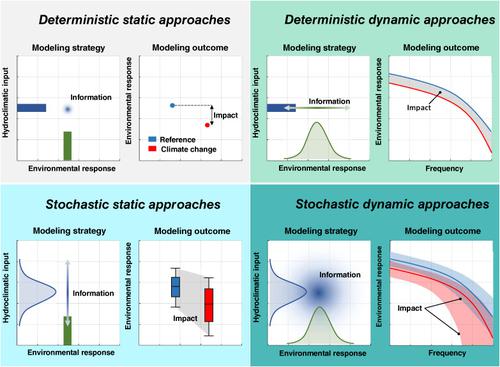当前位置:
X-MOL 学术
›
WIREs Clim. Chang.
›
论文详情
Our official English website, www.x-mol.net, welcomes your feedback! (Note: you will need to create a separate account there.)
Climate change and freshwater ecology: Hydrological and ecological methods of comparable complexity are needed to predict risk
WIREs Climate Change ( IF 9.2 ) Pub Date : 2020-11-18 , DOI: 10.1002/wcc.692 Andrew John 1 , Avril Horne 1 , Rory Nathan 1 , Michael Stewardson 1 , J. Angus Webb 1 , Jun Wang 2 , N. LeRoy Poff 3, 4
WIREs Climate Change ( IF 9.2 ) Pub Date : 2020-11-18 , DOI: 10.1002/wcc.692 Andrew John 1 , Avril Horne 1 , Rory Nathan 1 , Michael Stewardson 1 , J. Angus Webb 1 , Jun Wang 2 , N. LeRoy Poff 3, 4
Affiliation

|
Many freshwater ecosystems are in decline because of anthropogenic disturbance including climate change, yet our understanding of ecological vulnerability to future conditions including climatic variation is limited. Understanding climate risks to freshwater ecosystems requires combining hydrological and ecological knowledge. While there have been significant advances in ecohydrological approaches when applied within the large array of methods available for undertaking impact assessments, the ecological and hydrological elements are often not well‐integrated. This results in a mismatch in their ability to accommodate the inherent uncertainty in both impacts and responses. We examine published literature that assesses climate change impacts on freshwater ecosystems using both hydrological and ecological models to better understand method choices. We identify four fundamentally distinct modeling approaches used to assess climate change risk. We discuss which approaches are less useful for predicting ecological impacts under climate change, and highlight approaches of comparable complexity that can maximize the utility of dynamic, process‐based modeling while capturing the effects of climate uncertainty and variability. Using an illustrative case study of riparian vegetation health under climate change, we show how the four alternate modeling approaches feature different degrees of information in their outcomes and inferences about future risk. Most current studies that examine climate change risks to freshwater ecosystems use simplified methods or inadequately combine key elements. However, unless the interactions between changing hydrologic variability and ecological responses are explicitly captured in scale‐sensitive modeling methods, the risks of climate change to freshwater ecosystems will likely be substantially misrepresented, with negative consequences for effective management responses. Capturing these interactions requires combining ecological and hydrological methods of comparable complexity.
中文翻译:

气候变化和淡水生态:需要相当复杂的水文和生态方法来预测风险
由于包括气候变化在内的人为干扰,许多淡水生态系统正在减少,但是我们对生态系统对未来条件(包括气候变化)的脆弱性的理解是有限的。了解淡水生态系统的气候风险需要结合水文和生态学知识。虽然在用于进行影响评估的大量可用方法中应用生态水文方法方面已取得了重大进展,但生态和水文要素通常没有很好地融合在一起。这导致他们在影响和应对方面固有的不确定性适应能力不匹配。我们审查了使用水文和生态模型评估气候变化对淡水生态系统影响的已发表文献,以更好地理解方法选择。我们确定了四种用于评估气候变化风险的根本不同的建模方法。我们讨论了哪些方法对预测气候变化下的生态影响不太有用,并重点介绍了可比较复杂性的方法,这些方法可以最大程度地利用基于过程的动态建模,同时捕获气候不确定性和可变性的影响。通过对气候变化下河岸植被健康的说明性案例研究,我们展示了四种替代建模方法在其结果和关于未来风险的推断中如何体现不同程度的信息。当前大多数研究气候变化对淡水生态系统的风险的研究都使用简化方法或未充分结合关键要素。然而,除非在尺度敏感的建模方法中明确记录了变化的水文变异性与生态响应之间的相互作用,否则气候变化对淡水生态系统的风险将很可能被严重误解,从而对有效的管理响应产生负面影响。捕捉这些相互作用需要结合相当复杂的生态和水文方法。
更新日期:2020-11-18
中文翻译:

气候变化和淡水生态:需要相当复杂的水文和生态方法来预测风险
由于包括气候变化在内的人为干扰,许多淡水生态系统正在减少,但是我们对生态系统对未来条件(包括气候变化)的脆弱性的理解是有限的。了解淡水生态系统的气候风险需要结合水文和生态学知识。虽然在用于进行影响评估的大量可用方法中应用生态水文方法方面已取得了重大进展,但生态和水文要素通常没有很好地融合在一起。这导致他们在影响和应对方面固有的不确定性适应能力不匹配。我们审查了使用水文和生态模型评估气候变化对淡水生态系统影响的已发表文献,以更好地理解方法选择。我们确定了四种用于评估气候变化风险的根本不同的建模方法。我们讨论了哪些方法对预测气候变化下的生态影响不太有用,并重点介绍了可比较复杂性的方法,这些方法可以最大程度地利用基于过程的动态建模,同时捕获气候不确定性和可变性的影响。通过对气候变化下河岸植被健康的说明性案例研究,我们展示了四种替代建模方法在其结果和关于未来风险的推断中如何体现不同程度的信息。当前大多数研究气候变化对淡水生态系统的风险的研究都使用简化方法或未充分结合关键要素。然而,除非在尺度敏感的建模方法中明确记录了变化的水文变异性与生态响应之间的相互作用,否则气候变化对淡水生态系统的风险将很可能被严重误解,从而对有效的管理响应产生负面影响。捕捉这些相互作用需要结合相当复杂的生态和水文方法。



























 京公网安备 11010802027423号
京公网安备 11010802027423号